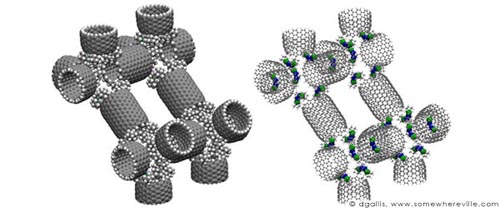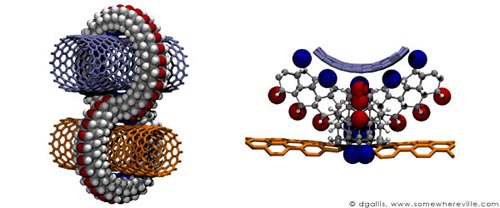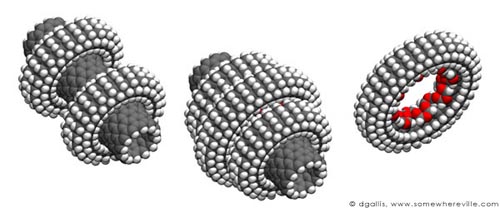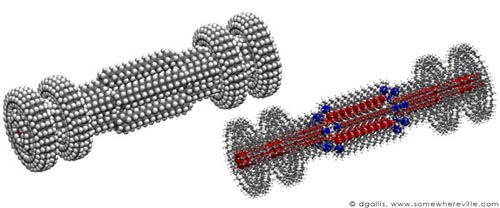Home > Nanotechnology Art Gallery > Damian Gregory Allis
Damian Gregory Allis
Click image to enlarge. All images © respective artist or company.
Carbon nanotube dative junction assembly

Dative (dipolar) bonds are a potentially valuable form of noncovalent interaction for use in diamondoid and macromolecular nanostructures. These interactions require a lone pair donor, such as the lone pair of nitrogen, and an acceptor, such as the empty sp2 orbital or boron. Boron and nitrogen are both good structural replacements for the C-H fragments found in hydrocarbons (nitrogen because it is isoelectronic with the C-H unit, boron because it can accommodate three covalent bonds to leave the last orbital empty). In this design, carbon nanotubes are functionalized with adamantane-based dative hinges that lock each fragment into place to form the extended network. (grey = carbon, white = hydrogen, blue = nitrogen, green = boron; left: van der Waals rendering. right: ball-and-stick rendering)
|
|
Crimp junctions for perpendicular carbon nanotube scaffolding 
In this design, two rigid diamondoid rings are fused at a quasi-tetrahedral junction and sized, through the addition or subtraction of repeat subunits in each ring, to accommodate two carbon nanotubes of different diameters. The crimping of the nanotubes is a result of van der Waals packing of the rings, a feature that can be enhanced or removed by adjusting the ring size. (grey = carbon, white = hydrogen, blue = nitrogen, red = oxygen) |
|
Low-friction bearing assembly with two carbon allotropes 
In this design, two diamondoid rings replace small segments of a carbon nanotube, providing a lock for a third, larger ring. The larger ring includes a stitch-work of oxygens to create an electron-rich interior whose effective circular van der Waals packing just touches that of the nanotube framework. |
|
Rigid rod-based nanomechanical gear assembly 
Here, a five-fold rotation axis in a single rigid rod is coupled to four rings composed of 15 subunits each. A pagodanoid junction is included along this rigid rod to raise the five sections of the assembly to create an elevated gearing system. The image at left is a van der Waals representation. At right, only the oxygen and nitrogen atoms are shown (as spheres) to highlight the rod interior. (grey = carbon, white = hydrogen, blue = nitrogen, red = oxygen) |
All images are the result of molecular mechanics structure calculations using either Tinker (MM2 parameters) or NAMD (CHARMM). Images were made with VMD. VMD and NAMD are developed with NIH support by the Theoretical and Computational Biophysics group at the Beckman Institute, University of Illinois at Urbana-Champaign. Tinker is a product of the Ponder Lab in the Department of Biochemistry and Molecular Biophysics at the Washington University School of Medicine. E. Zelman and Apple Computer are thanked for their generous donation of resources. Any inquiries concerning methods, software, or shop talk are directed to www.somewhereville.com.
|
|
||
|
|
||
| The latest news from around the world, FREE | ||
|
|
||
|
|
||
| Premium Products | ||
|
|
||
|
Only the news you want to read!
Learn More |
||
|
|
||
|
Full-service, expert consulting
Learn More |
||
|
|
||